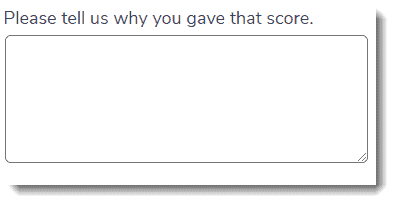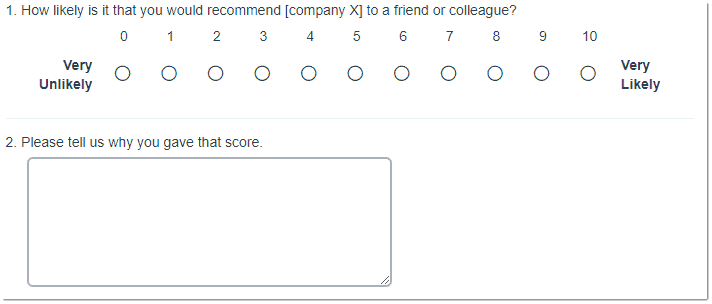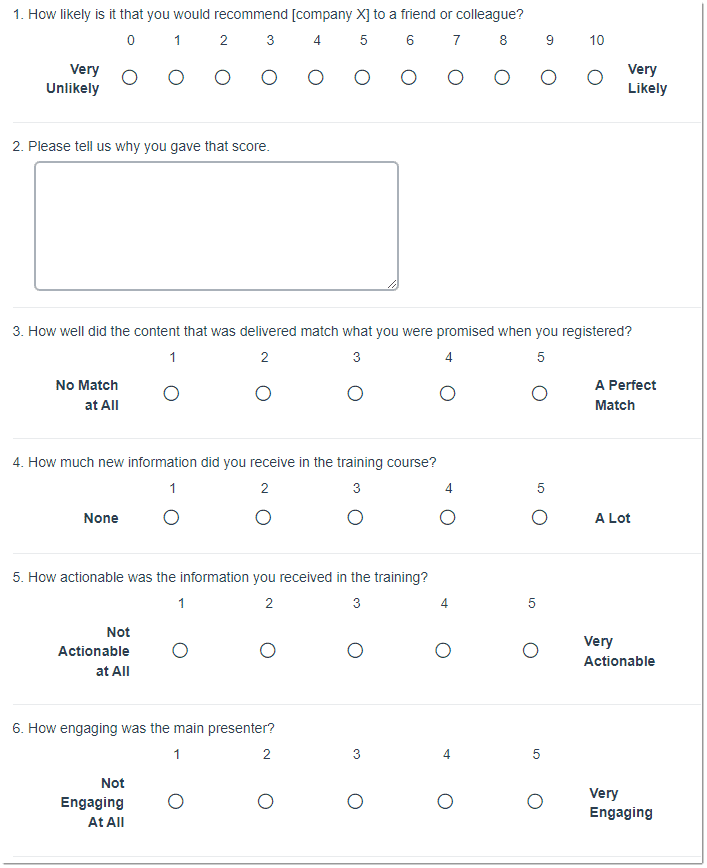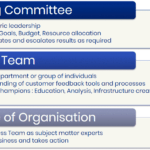Net Promoter Score is of course famous for being the …
The one number you need to grow…
Frederick F. Reichheld
… and this fame has lead some people to think that you only need one question in your Net Promoter Survey.
This is incorrect.
A Net Promoter survey needs to be short and targeted but it also needs to have more than just one question.
I’ve designed hundreds of NPS surveys for large and small, B2B and B2C companies. Here are the key elements of a perfect Net Promoter Survey design.
Net Promoter Survey Design Goals
A lack of design goals is why so many surveys seem to have a split personality. They ask a few market research questions then a few customer feedback questions and even toss in a couple of marketing pushes.
This leads to a confused survey structure that is almost always too long and long surveys are not high response rate surveys.
Here are your Net Promoter Survey design goals:
Maximise Response Rate
The idea is to collect data so you need to maximise the number of people that respond to your survey. There are many ways to do this – here’s quick summary:
- Make is as short as possible – but remember one question is too short.
- Have a short, direct, easy to understand and act on invite.
- Ensure all the questions makes sense.
- Ensure the invite and survey work on mobile, tablet and desktop systems.
Make it Accurate and Consistent
The factors that can skew a Net Promoter Score survey response are many and varied.
To reduce the changes in these factors as much as possible you want to ensure that the survey is consistent from one customer to the next and one wave or transaction to the next.
Resist the urge to re-order questions, add new ones, change the wording of existing questions, etc.
Collect Information on How to Improve
You need to understand what is driving NPS for the information to be of any use.
Asking one question, as some NPS® surveys do, is pretty much a waste of time unless you have an extraordinarily deep and wide customer behaviour dataset and the tools to do some very sophisticated data analysis.
For most organisations you will need to add questions to understand what drives the score.
Questions to Exclude
There are also some elements that should be excluded from the NPS survey.
We don’t care if the customer might like to purchase that new service Marketing has been pushing or whether they follow us on Twitter.
Those questions are not relevant to the customer experience improvement process and have no place in our customer feedback survey.
Now that we have a good set of design goals the actual survey part should flow pretty easily.
The Net Promoter Score Question
Starting with the “Would Recommend” or “likelihood to recommend” question seems like a pretty good idea, and it is.
Putting this question at the start of the survey is generally considered best practice because it allows you to change later questions, if needed, and not affect the score from the first question.
The easiest approach is to just use the question as designed:

Can You Change the NPS Response Scale?
Yes, but why would you? Typically this is how I hear this question:
Our Market Research/Customer Insights/Analytics Department has standardised on the 0-5/1-7/Alpha-Omega, response scale and we need to conform to their requirements.
While it is possible to change the response scale, all of the analysis and published NPS literature is based on the 0-10 response scale so all of that data is worthless if you change the scale. 0-10 works and has been proven to work.
If you can push back against Market Research/Customer Insights/Analytics Department then do so.
If you can’t it’s not the end of the world but it does make things a bit tricky.
Can You Change the NPS Question Wording?
As long as you are consistent it is generally agreed that you can change the wording a minor way to focus the respondent on a particular part of the organisation or transaction.
This works quite well for transactional surveys because you can link the respondent more closely to the transaction.
It it is also agreed that you can change the reference to a “friend or colleague” to a cohort that makes sense in the context of your business, e.g. “business colleague”, or “team mate”
However, changing the question away from the “would recommend” wording or changing the ends of the scales away from Very Unlikely or Very Likely is not generally accepted.
8 Examples of Valid and Invalid Net Promoter Score Questions
Valid NPS Question – The Original Question
This is the form of the question originally published in the Harvard Business Review article.
![How likely is it that you would recommend [company X] to a friend or colleague?](https://www.genroe.com/wp-content/uploads/valid-nps-question-original.png)
Valid NPS Question – Links “would recommend” to a Specific Transaction

Valid NPS Question – Links to Appropriate Cohort
By adding the term “team mate” this question helps focus the respondent on an appropriate cohort for recommendation.

Valid NPS Question – Links to Appropriate Cohort
By adding the term “business associate” this question helps focus the respondent on an appropriate cohort for recommendation.

Valid NPS Question – Relationship Version
This question does not reference a specific transaction and becomes a good approach for a Relationship NPS survey.

Invalid NPS Question – Uses an “agree / disagree” construction
While this type of “agree/disagree” question construction is very common in market research it is not an appropriate way to ask the NPS question.

Invalid NPS Question – Asks about Satisfaction
One of the goals of the original research was to find a question that correlated with loyalty better than the existing customer satisfaction approach.

Invalid NPS Question – Asks about Loyalty
While one of the goals of the NPS research was to identify a predictor of loyalty it was discovered in that research that asking directly gave poorer outcomes than asking about “recommendation”.

Qualitative / Free Text Question(s)
The qualitative or free text question is a staple in a Net Promoter Survey because it provides the how to match the what we discover later.
This is an open response question that, if the survey is well designed, will receive a 40-60% completion rate.

There are nuances that you can introduce such as changing the question in response to high and low scores to the “would recommend” question, e.g.
Please tell us how we can improve.
Please tell us what you liked the most about us.
In general this is not necessary but there is no harm in doing so.
NPS Driver Identification
Now you know the score and what to improve, you need know how to drive change so you need a way to identify what drives the NPS. This is the task of the driver identification part of the survey.
There are three main ways to run this section of the survey. Which you select depends on a variety of factors but let’s introduce each and then summarise the applications.
1. Driver Identification By Tagging The Free Text
The first method for driver analysis is to tag each of the free text comments with a theme or themes then use these tags to analyse the data and identify the most important tags.
This requires you to tag the data and there are several ways to achieve that task.
Manual Tagging
If you don’t have many responses, maybe just one or two hundred, you can use the manual tagging approach. This works well if the same person does all of the tagging and you limit the number of tags to just 10 or 20.
Of course this is quite subjective which is why you should have the same person do the tagging to keep it consistent. As you can imagine, though, this gets old pretty quickly.
Automated Text Analytics (Passive Tagging)
Computers can do a lot of things and analyse the text from your free text question is one of them. There are a variety of platforms that will take the text and parse it to provide a context and tag the response.
However, text analytics tools are not as point and shoot as they seem, or as advertised. These systems require training, technical skills and ongoing management to match them to your business.
They can also be expensive but they can be effective for large numbers of responses.
2. Customer Tagging (Active Tagging)
The last way to tag data is to have the customer complete the task. Of course you don’t call it “tagging” in the survey but that’s what they are doing.
To achieve this you add one more question to the survey with a series of check-boxes or radio buttons to allow the customer to tell you what was their biggest issue or what they liked the most.
This works very well and has the added of advantage of not needing to manage text analytics tools and never being wrong. After all, by definition, a customer can’t tag their data incorrectly.
3. Attribute Questions
The alternative to tagging of the responses is to use a series of attribute questions to score each of the attributes of your product or service.
For example:

Using these scores you can determine which attributes are important to the customer and how well you are delivering them. This helps you to understand where you need to focus your improvement efforts.
This approach has the advantage of being quite clear cut to implement but the attribute list needs to be comprehensive.
The other issue with this approach is it increases the length of the survey (remember our goals). However, done carefully this works well.
Take care that you only include the attributes that are really essential otherwise you will grow a Christmas Tree survey: one with all sorts of questions hanging off it.
Attribute questions can make the task of identifying the driver attributes a little easier because the statistical analysis is relatively simple; predominately linear regression models.
NPS Survey Templates
Each of the perfect Net Promoter Surveys below meets our original set of goals:
- Short
- Consistent
- Enable driver identification
- Understand how to improve
- Collect NPS
So let’s review the various versions and highlight when they should be used.
Position of the NPS Question in the Survey
Research shows a significant position effect for the “Recommend” question in surveys. In short, you get higher NPS scores if you ask the question first, lower if you ask it last in the survey.
The Minimum Possible NPS Survey
The absolute minimum effective survey is to combine a valid NPS question with a free text response and then use manual tagging or automated text analysis to understand what is driving the score, i.e. how to improve.

Longer NPS Surveys
Once you have the minimum number of questions – if you want – you can add more questions to make the analysis of the data a little easier.
Ensure that you follow good survey design practices and don’t add too many questions.
Here’s an example of a slightly longer NPS survey that would still get good response rates while also collecting important driver information.

Net Promoter Score Survey Design Questions
There are a few different ways to increase response rates to your NPS survey. Firstly, you can make sure your survey is as concise and clear as possible. Secondly, ensure that the invite and survey can be read easily on all devices: mobile, desktop and tablet. Lastly, personalize your survey to make it more relevant to each respondent.
For Relationship Net Promoter Score Surveys you can run them multiple times a year, but no more than once very 90 days. On the other hand Transactional surveys should be run after every transaction, with a block period so you don’t over survey customers. This will help you stay up-to-date on customer feedback, identify areas for improvement and track progress over time.
Measuring Net Promoter Score is important because it helps you gain insights into how your customers feel about your products and services. With it you can track their customer loyalty over time, and make changes to improve customer experience, customer loyalty and ultimately business profit.
While some organisations do change the NPS question scale from 0-10 to 1 to 5, 1 to 7 or other variants. There is little evidence that this improve results. It’s commonly acknowledged that the 0 on the 0-10 scale is a strong indicator to respondents that 0 is the low end of the scale which can reduce unintentional scale flipping.
Small changes in the wording of the NPS question are generally acceptable, particularly where it helps to focus the respondent on an area of the business or cohort, e.g. “Based on your recent contact centre interaction…” However, changing the scale endpoint (Very Unlikely, Very Likely) or the “would recommend” part of the question is not advised.








